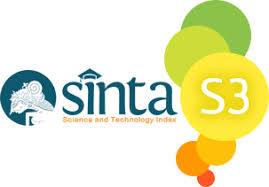Penggunaan komunikasi non-verbal bahasa tubuh dalam desain instruksional pelatih dan atlet kategori tanding pencak silat
 Abstract views: 2140
,
Abstract views: 2140
,
 PDF downloads: 2518
PDF downloads: 2518
Abstract
Instruction is a form of information exchange with the aim to provide understanding and influence on the behavior of martial arts athletes by the trainers. Clear instructions, will facilitate the athlete in understanding the message delivered, will automatically also affect the performance of athletes in the game. Therefore, to facilitate and clarify in the delivery of instructions, the need for non-verbal body language as a supporter of such verbal instructions. Body language is a process of exchanging information that is done by using limbs as a medium of information. Although every body movement has a variety of meanings for everyone. However, in martial arts the units of Unitomo Surabaya made certain movements which were considered to be able to support verbal instruction, then the movement was given a meaning which was in accordance with the rules of usage and on the basis of mutual agreement by trainers and athletes, and the communication process was made as tradition by the group.
Keywords: instructional design; non-verbal communication; athlete
References
Huda, J. M., Prasetyo, I. J., & Fitriyah, I. (2019). Komunikasi Interpersonal Antar ODHA untuk Menumbuhkan Motivasi Kembali Hidup Normal di Yayasan Mahameru Surabaya. Jurnal Komunikasi Profesional, 3(1).
Mingkid, E. (2015). Penggunaan media komunikasi promosi pariwisata oleh pemerintah Kota Manado. Sosiohumaniora, 17(3), 188-192.
Mulyana, D. (2004). Komunikasi Efektif. Bandung: PT. Remaja Rosdakarya. MUNAS (Musyawarah Nasional) 2007:ii XII IPSI
Putranto, T. D. (2018). Kelas Sosial Dan Perempuan Generasi Z di Surabaya Dalam Membuat Keputusan Setelah Lulus Sekolah Menengah Atas. Jurnal Komunikasi Profesional, 2(1).
Putri, N. S. R., & Farida, F. (2018). Pembentukan Citra Diri Mahasiswa Fakultas Ilmu Komunikasi Universitas dr. Soetomo Surabaya dalam Instagram. Jurnal Kajian Media, 2(2).
Sobur, A. (2004). Semiotika Komunikasi. Bandung: PT. Remaja Rosdakarya.
Susilo, D., Baihaqi, A., Maela, N. F. S., & Fitriyah, I. (2018). Komunikasi Keluarga Buruh Migran Indonesia: Hambatan dan Penyelesaian. JIKE: Jurnal Ilmu Komunikasi Efek, 1(2), 166-188.
Tuela, M., & Susilo, D. (2017). Hyperreality: Pemaknaan dalam Penggunaan Game Pokemon Go. Jurnal Kajian Media, 1(1).
Winarti, O. (2018). Language Shift of Krama to Bahasa Indonesia among Javanese Youths and it’s Relation to Parents’ Social Class. Jurnal Studi Komunikasi, 2(3), 290-300.
Copyright (c) 2019 Jurnal Komunikasi Profesional

This work is licensed under a Creative Commons Attribution-ShareAlike 4.0 International License.

Jurnal Komunikasi Profesional is licensed under a Creative Commons Attribution-ShareAlike 4.0 International License.
1. Proposed Policy for Journals That Offer Open Access
Authors who publish with this journal agree to the following terms:
- Authors retain copyright and grant the journal right of first publication with the work simultaneously licensed under a Creative Commons Attribution License that allows others to share the work with an acknowledgment of the work's authorship and initial publication in this journal.
- Authors are able to enter into separate, additional contractual arrangements for the non-exclusive distribution of the journal's published version of the work (e.g., post it to an institutional repository or publish it in a book), with an acknowledgement of its initial publication in this journal.
- Authors are permitted and encouraged to post their work online (e.g., in institutional repositories or on their website) prior to and during the submission process, as it can lead to productive exchanges, as well as earlier and greater citation of published work (See The Effect of Open Access).
2. Proposed Policy for Journals That Offer Delayed Open Access
Authors who publish with this journal agree to the following terms:
- Authors retain copyright and grant the journal right of first publication, with the work [SPECIFY PERIOD OF TIME] after publication simultaneously licensed under a Creative Commons Attribution License that allows others to share the work with an acknowledgement of the work's authorship and initial publication in this journal.
- Authors are able to enter into separate, additional contractual arrangements for the non-exclusive distribution of the journal's published version of the work (e.g., post it to an institutional repository or publish it in a book), with an acknowledgement of its initial publication in this journal.
- Authors are permitted and encouraged to post their work online (e.g., in institutional repositories or on their website) prior to and during the submission process, as it can lead to productive exchanges, as well as earlier and greater citation of published work (See The Effect of Open Access).



